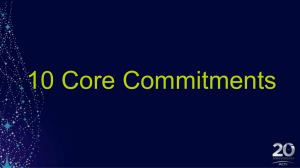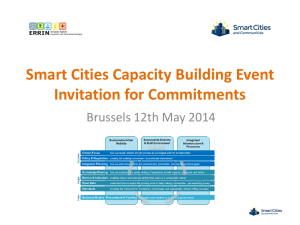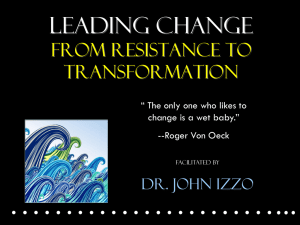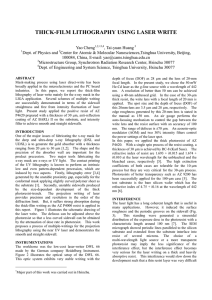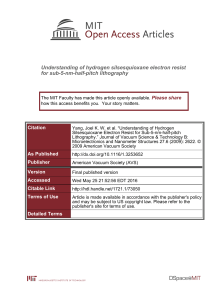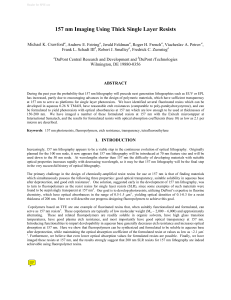Change Management
advertisement
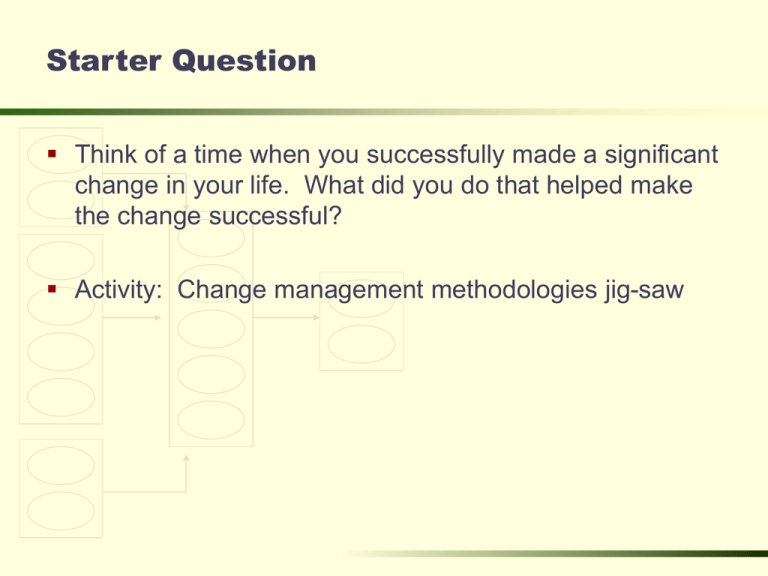
Starter Question Think of a time when you successfully made a significant change in your life. What did you do that helped make the change successful? Activity: Change management methodologies jig-saw Organizational Change Is Central to OD Organizational change differs on several dimensions: Planned vs. Unplanned Planned changes are intentional Unplanned are in response to context changes (e.g., crisis) First-order vs. Second-order First-order = incremental changes within an existing framework Second-order = transformational changes that change the framework Episodic vs. Continuous Episodic change represents infrequent change that occurs during specific periods of time Continuous change reflects that belief that things are always changing Change can occur at multiple levels: -Individual -Group/Team -Organization -Inter-organization Making Change Happen Types of organizational change activities: Catalytic interventions assist members in making changes Data presentations and analysis, decision explanations, etc. Acceptant activities help members discover and disclose their ideas and feelings about the change(s) Outside consultant facilitating “bitch sessions” Confrontation interventions allow members to challenge cultural and normative practices For a change to be successful, one or more must be present: Relative advantage of the proposed change over the status quo Compatibility of the change(s) with the culture Complexity of the changes(s) matches the organization’s ability Trialability in that change(s) can be rolled back Observability so that the benefit(s) of the change(s) are seen Change Management Process Case for change Taking charge Cascade Align Report Process Execute & revise review Feedback Process Goals/Objectives Develop and implement actionable long and short-term strategies and tactics Measure results and progress Review progress and corrections as necessary Engage all stakeholders and plan for transition management Appreciative Inquiry is another process for achieving change: Discovery – collect information/data on the good and the bad Dream – share visions for the future Design – collaboratively construct future vision and actions Destiny – empower at the grossroots level to attain the vision SMART Objectives for Change Specific Is it clear, understandable, and well defined? Measurable Can the result of the objective be quantified? Aligned Does the objective fit with the higher-level direction and commitments to action? Are interdependencies identified and addressed? Relevant Is this a high impact driver of achieving the higherlevel direction and commitments to action? Do I have the necessary authority, knowledge, and skill to accomplish the objective? Time-Based Is a start date and completion date assigned? SMART Objectives Come from a SWOT Strengths Weaknesses Opportunities Threats Individual-level Change Example Opportunities Initiative Increase the number of distance learning classes Stretch Goals Each course listing has a distance learning equivalent Metrics Ratio of distance learning classes per course offering Personal Commitments Deans commits to % increase in distance learning classes per academic year Results and Feedback 30 new distance learning classes added Change through Alignment Strategy Defend the Core: Latest & Greatest Technology & Services Aggressively Grow SoHo: Solutions for Starting and Running a Successful Business Top 100 Best Companies to Corporate Work for Values Values Fanatical Customer Respect for the IndividualFirst Customer Service Respect Excellence in Execution Passion to Succeed Transformation InitiativesInitiatives Invest Shop Customer Focus Winning Culture Profitable Growth Areas of Focus • Customer Experience • Build CompUSA Brand Success Metrics Reduce Turnover 20% Improve EE Index 10% Improve Diversity Index 10% Compelling Work Environment Committed, Involved Employees Diversity in Action • TM Training, Fastest Growing Segments Dev., in and Engagement All Markets • Best-in-Class TM • Drive Margins Lowest Cost Structure • Drive Growth in the Industry • Drive Cash Flow Grow Revenue $400 Million Profitable Sales Velocity Right Product, Right Time Customer Service COMMITMENTS TO ACTION Reduce Expenses $100 Million Forces Resisting Change Internal and External Forces for Change External: outside the organization Demographic characteristics Technology Market changes Social and political pressure Internal: inside the organization Human resource problems/prospects Managerial behavior/decisions 4 Why People Resist Change An individual’s predisposition to change Surprise and fear of the unknown Climate of mistrust Fear of failure Loss of status or job security Peer pressure Disruption of cultural traditions or group relationships Personality conflicts Lack of tact or poor timing Nonreinforcing reward systems 5 Overcoming Resistance to Change Education and Communication: This method is best when employees either have no information or incorrect information. Once persuaded, people will help implement the change but it can be time consuming. Participation and Involvement: This method is best if managers initiating the change don’t have the information to design the change or if people have power to resist. People who participate will be committed to get the change rolling and they will share any information they have relevant to the change. This approach can be time consuming especially if an inappropriate change is implemented. Facilitation and Support: This is best to use when people are having difficulty adjusting to the change so they resist it. No other approach works as well for employees with adjustment problems. It can be time consuming and expensive and the method could still fail. Negotiation and Agreement: If a group will obviously lose if the change is implemented and this group has the power to resist change, then this method is best. It is a relatively easy way to avoid resistance. It might also be expensive and if those resisting catch on to your negotiation tactics, they may try to negotiate to avoid the change all together. Manipulation and Co-optation: This approach is best if everything else fails or is too expensive to implement. It can be a quick and inexpensive way to solve problems. It might lead to more problems if people feel manipulated. Explicit and Implicit Coercion: If speed is of the essence than this approach is best. It works quickly and can overcome resistance. It can however be risky if people become angry at the initiators of the change. 7 Planning and Benefits Planning: is the process of setting goals and deciding how to achieve them. Planning helps you check on your progress. Planning helps you coordinate activities. Planning helps you think ahead. Above all, planning helps you cope with uncertainty. 5 The Planning Process Mission Statement Vision Statement Strategic Planning Tactical Planning Operational Planning Goals Goals Goals Action plans Action plans Action plans 6




